[English] 日本語
 Yorodumi
Yorodumi- PDB-6wbg: Cryo-EM structure of human Pannexin 1 channel with its C-terminal... -
+ Open data
Open data
- Basic information
Basic information
| Entry | Database: PDB / ID: 6wbg | ||||||||||||
|---|---|---|---|---|---|---|---|---|---|---|---|---|---|
| Title | Cryo-EM structure of human Pannexin 1 channel with its C-terminal tail cleaved by caspase-7 | ||||||||||||
 Components Components | Pannexin-1 | ||||||||||||
 Keywords Keywords | TRANSPORT PROTEIN / ion channel | ||||||||||||
| Function / homology |  Function and homology information Function and homology informationATP transmembrane transporter activity / ATP transport / Electric Transmission Across Gap Junctions / leak channel activity / positive regulation of interleukin-1 alpha production / wide pore channel activity / bleb / monoatomic anion transmembrane transport / monoatomic anion channel activity / gap junction ...ATP transmembrane transporter activity / ATP transport / Electric Transmission Across Gap Junctions / leak channel activity / positive regulation of interleukin-1 alpha production / wide pore channel activity / bleb / monoatomic anion transmembrane transport / monoatomic anion channel activity / gap junction / gap junction channel activity / positive regulation of macrophage cytokine production / Mechanical load activates signaling by PIEZO1 and integrins in osteocytes / oogenesis / response to ATP / The NLRP3 inflammasome / monoatomic cation transport / response to ischemia / positive regulation of interleukin-1 beta production / calcium channel activity / actin filament binding / calcium ion transport / cell-cell signaling / protease binding / scaffold protein binding / High laminar flow shear stress activates signaling by PIEZO1 and PECAM1:CDH5:KDR in endothelial cells / transmembrane transporter binding / signaling receptor binding / endoplasmic reticulum membrane / structural molecule activity / endoplasmic reticulum / protein-containing complex / identical protein binding / membrane / plasma membrane Similarity search - Function | ||||||||||||
| Biological species |  Homo sapiens (human) Homo sapiens (human) | ||||||||||||
| Method | ELECTRON MICROSCOPY / single particle reconstruction / cryo EM / Resolution: 2.97 Å | ||||||||||||
 Authors Authors | Lu, W. / Du, J. / Ruan, Z. | ||||||||||||
| Funding support |  United States, 3items United States, 3items
| ||||||||||||
 Citation Citation |  Journal: Nature / Year: 2020 Journal: Nature / Year: 2020Title: Structures of human pannexin 1 reveal ion pathways and mechanism of gating. Authors: Zheng Ruan / Ian J Orozco / Juan Du / Wei Lü /  Abstract: Pannexin 1 (PANX1) is an ATP-permeable channel with critical roles in a variety of physiological functions such as blood pressure regulation, apoptotic cell clearance and human oocyte development. ...Pannexin 1 (PANX1) is an ATP-permeable channel with critical roles in a variety of physiological functions such as blood pressure regulation, apoptotic cell clearance and human oocyte development. Here we present several structures of human PANX1 in a heptameric assembly at resolutions of up to 2.8 angström, including an apo state, a caspase-7-cleaved state and a carbenoxolone-bound state. We reveal a gating mechanism that involves two ion-conducting pathways. Under normal cellular conditions, the intracellular entry of the wide main pore is physically plugged by the C-terminal tail. Small anions are conducted through narrow tunnels in the intracellular domain. These tunnels connect to the main pore and are gated by a long linker between the N-terminal helix and the first transmembrane helix. During apoptosis, the C-terminal tail is cleaved by caspase, allowing the release of ATP through the main pore. We identified a carbenoxolone-binding site embraced by W74 in the extracellular entrance and a role for carbenoxolone as a channel blocker. We identified a gap-junction-like structure using a glycosylation-deficient mutant, N255A. Our studies provide a solid foundation for understanding the molecular mechanisms underlying the channel gating and inhibition of PANX1 and related large-pore channels. | ||||||||||||
| History |
|
- Structure visualization
Structure visualization
| Movie |
 Movie viewer Movie viewer |
|---|---|
| Structure viewer | Molecule:  Molmil Molmil Jmol/JSmol Jmol/JSmol |
- Downloads & links
Downloads & links
- Download
Download
| PDBx/mmCIF format |  6wbg.cif.gz 6wbg.cif.gz | 440.4 KB | Display |  PDBx/mmCIF format PDBx/mmCIF format |
|---|---|---|---|---|
| PDB format |  pdb6wbg.ent.gz pdb6wbg.ent.gz | 362.1 KB | Display |  PDB format PDB format |
| PDBx/mmJSON format |  6wbg.json.gz 6wbg.json.gz | Tree view |  PDBx/mmJSON format PDBx/mmJSON format | |
| Others |  Other downloads Other downloads |
-Validation report
| Summary document |  6wbg_validation.pdf.gz 6wbg_validation.pdf.gz | 2.2 MB | Display |  wwPDB validaton report wwPDB validaton report |
|---|---|---|---|---|
| Full document |  6wbg_full_validation.pdf.gz 6wbg_full_validation.pdf.gz | 2.2 MB | Display | |
| Data in XML |  6wbg_validation.xml.gz 6wbg_validation.xml.gz | 83.3 KB | Display | |
| Data in CIF |  6wbg_validation.cif.gz 6wbg_validation.cif.gz | 102.6 KB | Display | |
| Arichive directory |  https://data.pdbj.org/pub/pdb/validation_reports/wb/6wbg https://data.pdbj.org/pub/pdb/validation_reports/wb/6wbg ftp://data.pdbj.org/pub/pdb/validation_reports/wb/6wbg ftp://data.pdbj.org/pub/pdb/validation_reports/wb/6wbg | HTTPS FTP |
-Related structure data
| Related structure data |  21589MC  6wbfC  6wbiC  6wbkC  6wblC  6wbmC  6wbnC M: map data used to model this data C: citing same article ( |
|---|---|
| Similar structure data |
- Links
Links
- Assembly
Assembly
| Deposited unit | 
|
|---|---|
| 1 |
|
- Components
Components
-Protein / Sugars , 2 types, 14 molecules ABCDEFG

| #1: Protein | Mass: 42247.441 Da / Num. of mol.: 7 Source method: isolated from a genetically manipulated source Source: (gene. exp.)  Homo sapiens (human) / Gene: PANX1, MRS1, UNQ2529/PRO6028 / Production host: Homo sapiens (human) / Gene: PANX1, MRS1, UNQ2529/PRO6028 / Production host:  Homo sapiens (human) / References: UniProt: Q96RD7 Homo sapiens (human) / References: UniProt: Q96RD7#6: Sugar | ChemComp-NAG / |
|---|
-Non-polymers , 4 types, 42 molecules 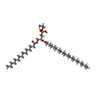
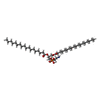
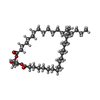




| #2: Chemical | ChemComp-PTY / #3: Chemical | ChemComp-3PE / #4: Chemical | ChemComp-DGA / #5: Chemical | ChemComp-CLR / |
|---|
-Details
| Has ligand of interest | N |
|---|---|
| Has protein modification | Y |
-Experimental details
-Experiment
| Experiment | Method: ELECTRON MICROSCOPY |
|---|---|
| EM experiment | Aggregation state: PARTICLE / 3D reconstruction method: single particle reconstruction |
- Sample preparation
Sample preparation
| Component | Name: Wild type human Pannexin 1 channel / Type: COMPLEX / Entity ID: #1 / Source: RECOMBINANT |
|---|---|
| Source (natural) | Organism:  Homo sapiens (human) Homo sapiens (human) |
| Source (recombinant) | Organism:  Homo sapiens (human) Homo sapiens (human) |
| Buffer solution | pH: 8 |
| Specimen | Conc.: 7 mg/ml / Embedding applied: NO / Shadowing applied: NO / Staining applied: NO / Vitrification applied: YES |
| Specimen support | Details: unspecified |
| Vitrification | Instrument: FEI VITROBOT MARK III / Cryogen name: ETHANE / Humidity: 100 % / Chamber temperature: 291.15 K |
- Electron microscopy imaging
Electron microscopy imaging
| Experimental equipment |  Model: Titan Krios / Image courtesy: FEI Company |
|---|---|
| Microscopy | Model: FEI TITAN KRIOS |
| Electron gun | Electron source:  FIELD EMISSION GUN / Accelerating voltage: 300 kV / Illumination mode: FLOOD BEAM FIELD EMISSION GUN / Accelerating voltage: 300 kV / Illumination mode: FLOOD BEAM |
| Electron lens | Mode: BRIGHT FIELD |
| Image recording | Average exposure time: 8 sec. / Electron dose: 49.6 e/Å2 / Detector mode: SUPER-RESOLUTION / Film or detector model: GATAN K2 SUMMIT (4k x 4k) |
- Processing
Processing
| Software | Name: PHENIX / Version: dev_3500: / Classification: refinement | ||||||||||||||||||||||||||||||||||||||||
|---|---|---|---|---|---|---|---|---|---|---|---|---|---|---|---|---|---|---|---|---|---|---|---|---|---|---|---|---|---|---|---|---|---|---|---|---|---|---|---|---|---|
| EM software |
| ||||||||||||||||||||||||||||||||||||||||
| CTF correction | Type: PHASE FLIPPING AND AMPLITUDE CORRECTION | ||||||||||||||||||||||||||||||||||||||||
| Particle selection | Num. of particles selected: 745206 | ||||||||||||||||||||||||||||||||||||||||
| Symmetry | Point symmetry: C7 (7 fold cyclic) | ||||||||||||||||||||||||||||||||||||||||
| 3D reconstruction | Resolution: 2.97 Å / Resolution method: FSC 0.143 CUT-OFF / Num. of particles: 88601 / Symmetry type: POINT | ||||||||||||||||||||||||||||||||||||||||
| Atomic model building | Protocol: AB INITIO MODEL / Space: REAL | ||||||||||||||||||||||||||||||||||||||||
| Refine LS restraints |
|
 Movie
Movie Controller
Controller













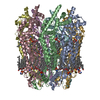


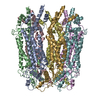

 PDBj
PDBj


















